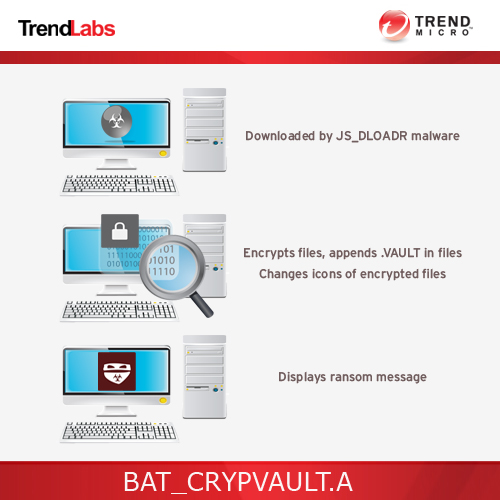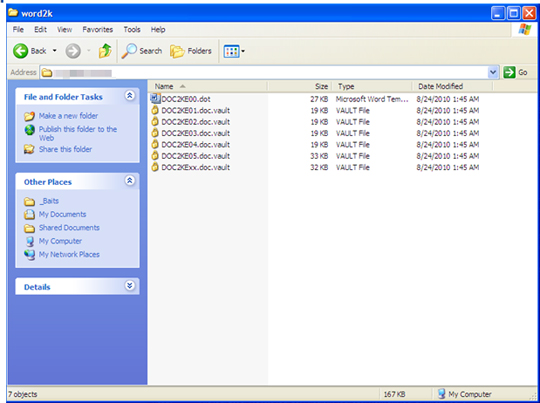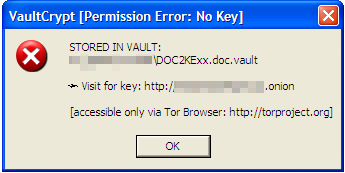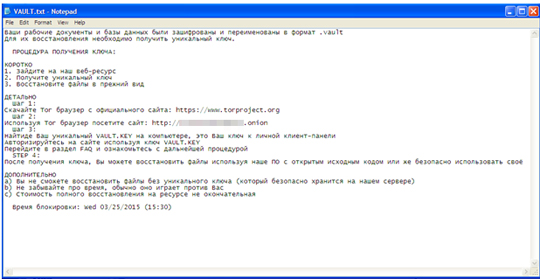BAT_CRYPVAULT.A
Trojan-Ransom.BAT.Scatter.al(Kaspersky); Ransom:BAT/Xibow.H(Microsoft); Trojan.Ransomcrypt.R(Symantec)
Windows


Threat Type: Trojan
Destructiveness: No
Encrypted: No
In the wild: Yes
OVERVIEW
This crypto-ransomware encrypts files and appends an extension that may look like it is a quarantined file. Quarantined files are usually done by anti-malware products.
To get a one-glance comprehensive view of the behavior of this Trojan, refer to the Threat Diagram shown below.

This Trojan may arrive bundled with malware packages as a malware component. It arrives on a system as a file dropped by other malware or as a file downloaded unknowingly by users when visiting malicious sites.
It deletes itself after execution.
TECHNICAL DETAILS
Arrival Details
This Trojan may arrive bundled with malware packages as a malware component.
It arrives on a system as a file dropped by other malware or as a file downloaded unknowingly by users when visiting malicious sites.
Installation
This Trojan drops the following files:
- %User Temp%\a.qq
- %User Temp%\gk.vlt
- %User Temp%\pk.vlt
- %User Temp%\vaultkey.vlt
- %User Temp%\cryptlist.lst
- %User Temp%\conf.list
- %User Temp%\confclean.list
- %User Temp%\cryptlist.cmd
- %User Temp%\up.vbs
- %User Temp%\ultra.js
- %User Temp%\VAULT.txt
- %User Temp%\VAULT.hta
- %appdata%\VAULT.hta
(Note: %User Temp% is the current user's Temp folder, which is usually C:\Documents and Settings\{user name}\Local Settings\Temp on Windows 2000, XP, and Server 2003, or C:\Users\{user name}\AppData\Local\Temp on Windows Vista, 7, and 8.)
Autostart Technique
This Trojan creates the following registry entries to enable automatic execution of dropped component at every system startup:
HKEY_CURRENT_USER\SOFTWARE\Microsoft\
Windows\CurrentVersion\Run
TNotification = "notepad %User Temp%\VAULT.txt"
HKEY_CURRENT_USER\SOFTWARE\Microsoft\
Windows\CurrentVersion\Run
VAULT Notification = "mshta %appdata%\VAULT.hta"
File Infection
This Trojan avoids infecting files that contain the following strings in their names:
- windows
- temp
- recycle
- program
- appdata
- avatar
- roaming
- msoffice
- temporary
- sample
- themes
- uploads
- csize
- resource
- internet
- com_
- intel
- common
- resources
- texture
- profiles
- library
- clipart
- manual
- games
- framework64
- setupcache
- autograph
- maps
- amd64
- cache
- support
- guide
- abbyy
- application
- thumbnails
- avatars
- template
- adobe
Download Routine
This Trojan connects to the following URL(s) to download its component file(s):
- http://{BLOCKED}lpknfp.onion.city
It saves the files it downloads using the following names:
- %User Temp%\enigma.exe
(Note: %User Temp% is the current user's Temp folder, which is usually C:\Documents and Settings\{user name}\Local Settings\Temp on Windows 2000, XP, and Server 2003, or C:\Users\{user name}\AppData\Local\Temp on Windows Vista, 7, and 8.)
Other Details
This Trojan encrypts files with the following extensions:
- *.xls
- *.doc
- *.rtf
- *.psd
- *.dwg
- *.cdr
- *.cd
- *.mbd
- *.1cd
- *.dbf
- *.sqlite
- *.jpg
- *.zip
- *.7z
It renames encrypted files using the following names:
- {file name and extension}.vault
It deletes itself after execution.
NOTES:
This malware recovers the following information from browsers installed on the affected system:
- Password
- User name
- Website
It requires the following files as its components for infection:
- %User Temp%\301.vlt
- %User Temp%\logs.vlt
- %User Temp%\temp.vlt
It then renames and executes them as part of its routine:
- %User Temp%\301.vlt renamed to audiodg.exe
- %User Temp%\logs.vlt renamed to svchost.exe
- %User Temp%\temp.vlt renamed to tick.exe
When the required components exist, it drops the following files:
- %appdata%\CONFIRMATION.KEY
- %appdata%\VAULT.KEY
- %User Temp%\ch.vlt
- %User Temp%\CONFIRMATION.KEY
- %User Temp%\cookie.vlt
- %User Temp%\random_seed
- %User Temp%\secring.gpg
- %User Temp%\trustdb.gpg
- %User Temp%\VAULT.KEY
- %User Temp%\VAULT2.KEY
- %User Temp%\win.vbs
- %userprofile%\Desktop\VAULT-README.txt
- %userprofile%\Desktop\VAULT.KEY
It encrypts file from drives B to Z. It deletes components used in encryption.
It changes the icons of encrypted files:

It opens a window with instructions to restore files whenever an encrypted file is accessed:

It displays it's ransom note %User temp%\VAULT.txt every system start up:

It displays it's ransom image %appdata%\VAULT.hta every system start up:

SOLUTION
Step 1
Before doing any scans, Windows 7, Windows 8, Windows 8.1, and Windows 10 users must disable System Restore to allow full scanning of their computers.
Step 2
Note that not all files, folders, and registry keys and entries are installed on your computer during this malware's/spyware's/grayware's execution. This may be due to incomplete installation or other operating system conditions. If you do not find the same files/folders/registry information, please proceed to the next step.
Step 3
Restart in Safe Mode
Step 4
Delete this registry value
Important: Editing the Windows Registry incorrectly can lead to irreversible system malfunction. Please do this step only if you know how or you can ask assistance from your system administrator. Else, check this Microsoft article first before modifying your computer's registry.
- In HKEY_CURRENT_USER\SOFTWARE\Microsoft\Windows\CurrentVersion\Run
- TNotification="notepad %User Temp%\VAULT.txt"
- TNotification="notepad %User Temp%\VAULT.txt"
- In HKEY_CURRENT_USER\SOFTWARE\Microsoft\Windows\CurrentVersion\Run
- VAULT Notification="mshta %appdata%\VAULT.hta"
Step 5
Search and delete these files
- %User Temp%\VAULT.txt
- %User Temp%\VAULT.hta
- %User Temp%\a.qq
- %User Temp%\gk.vlt
- %User Temp%\pk.vlt
- %User Temp%\vaultkey.vlt
- %User Temp%\cryptlist.lst
- %User Temp%\conf.list
- %User Temp%\confclean.list
- %User Temp%\cryptlist.cmd
- %User Temp%\up.vbs
- %User Temp%\ultra.js
- %User Temp%\enigma.exe
- %User Temp%\audiodg.exe
- %User Temp%\svchost.exe
- %User Temp%\tick.exe
- %User Temp%\ch.vlt
- %User Temp%\win.vbs
- %User Temp%\cookie.vlt
- %User Temp%\VAULT.KEY
- %User Temp%\secring.gpg
- %User Temp%\trustdb.gpg
- %User Temp%\random_seed
- %User Temp%\CONFIRMATION.KEY
- %User Temp%\VAULT2.KEY
- %appdata%\VAULT.hta
- %appdata%\CONFIRMATION.KEY
- %appdata%\VAULT.KEY
- %userprofile%\Desktop\VAULT.KEY
- %userprofile%\Desktop\VAULT-README.txt
Step 6
Restart in normal mode and scan your computer with your Trend Micro product for files detected as BAT_CRYPVAULT.A. If the detected files have already been cleaned, deleted, or quarantined by your Trend Micro product, no further step is required. You may opt to simply delete the quarantined files. Please check this Knowledge Base page for more information.
Did this description help? Tell us how we did.


